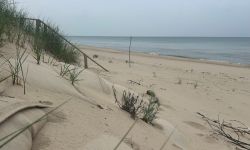Michigan: Reduce size limit for northern pike in some lakes

Northern pike are smaller than they should be in some Michigan lakes, so the Department of Natural Resources wants to remove the minimum size limit to catch the fish in those waters.
The fish, a top predator in many Michigan waters, aren’t maturing well in 10 lakes, preventing them from reaching the 24-inch minimum state limit and leading to a population surge, according to Seth Herbest, the DNR’s aquatic species and regulatory affairs manager.
To reduce the population and encourage anglers to catch more northern pike, the DNR is recommending the Natural Resources Commission this week consider removing the minimum size limit and increase the daily limit from two to five in the fall.
Related:
- Bird flu has killed nearly 1,500 Caspian terns on Lake Michigan islands
- Humans help endangered piping plover chicks survive on Michigan beaches
- Water test: Rending the Great Lakes food web
“Ideally, this would increase harvest which then would increase the number of prey per northern pike and increase their growth rate while allowing anglers to take more fish home,” Herbest said.
The new regulations would apply to lakes McCoy in Osceola County, Black in Cheboygan and Presque Isle counties, Pickerel in Emmet County, McCollum in Oscoda and Alcona counties, Gulliver and Worchester in Schoolcraft County, Little Long in Clare County, Bills in Newaygo County, Long in Ionia County and Kaks in Luce County.
The northern pike are single dorsal fin fish with light colored spots that are commonly found in the weedy shallows of both the Great Lakes and inland waters. They are a popular sports fish because they taste great and can be caught spearfishing.
About 90 percent of the northern pike’s diet is smaller fish, like yellow perch and sunfish, but they also eat any living creature they can chomp on such as frogs, crayfish, waterfowl or rodents.
Mature northern pike have few natural predators beyond sea lampreys and humans.
That means the northern pike can have a significant impact on its prey species, causing large-scale changes in populations and even extinctions. In some states, like California, northern pike have eaten so many trout and salmon they’ve changed ecosystems.
The primary reason fish populations become stunted is an overabundance of the species, said Jim Diana, a retired fisheries and aquaculture professor at the University of Michigan.
In stunted northern pike, the fish will grow to a maximum 18 or 19 inches instead of more than 20 inches in three years. When fish are stunted, they breed earlier, produce fewer eggs and lead to fewer generations of northern pike.
Reducing fish populations, therefore, can actually help species grow better, Diana said.
Floyd Dropps, chair of the Upper Peninsula Sportsmen's Alliance, said U.P. anglers have pressed the DNR to remove the size limit for northern pike for years.
“You could go out there and catch 20 pikes but you wouldn’t be able to keep any of them because they’re too small,” Dropps said.
This discourages a lot of anglers from fishing the northern pike, Dropps said.
“The overabundance of pike is also hard on the other fisheries,” Dropps said, noting that walleye are suffering in lakes near him because of large numbers of pike.
Dropps said he believes reducing the minimum size limit “won’t hurt anything,” and would “help take some smaller fish so the population is not quite so abundant.”
Dennis Eade, executive director of Michigan Steelhead and Salmon Fishermen’s Association, said reducing the size limit could help other anglers.
“It would reduce the number of predator fish that would increase the number of panfish that are available,” Eade said, noting pan fish are species that make a nice meal, like yellow perch or blue gills.
Eade says the northern pike are an advantageous, aggressive species that will target fish far too big for it to eat and “can choke on them.”
According to Eade, a minimum size limit helps sustain some fish populations because “it gives them ample opportunity to become dominant in the system.”
Michigan Environment Watch
Michigan Environment Watch examines how public policy, industry, and other factors interact with the state’s trove of natural resources.
- See full coverage
- Subscribe
- Share tips and questions with Bridge environment reporter Kelly House
Michigan Environment Watch is made possible by generous financial support from:
Our generous Environment Watch underwriters encourage Bridge Michigan readers to also support civic journalism by becoming Bridge members. Please consider joining today.
See what new members are saying about why they donated to Bridge Michigan:
- “In order for this information to be accurate and unbiased it must be underwritten by its readers, not by special interests.” - Larry S.
- “Not many other media sources report on the topics Bridge does.” - Susan B.
- “Your journalism is outstanding and rare these days.” - Mark S.
If you want to ensure the future of nonpartisan, nonprofit Michigan journalism, please become a member today. You, too, will be asked why you donated and maybe we'll feature your quote next time!






